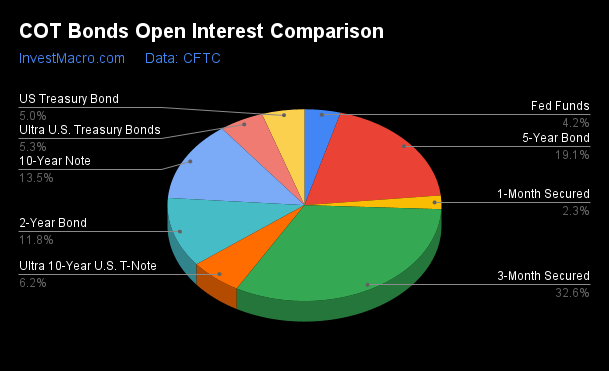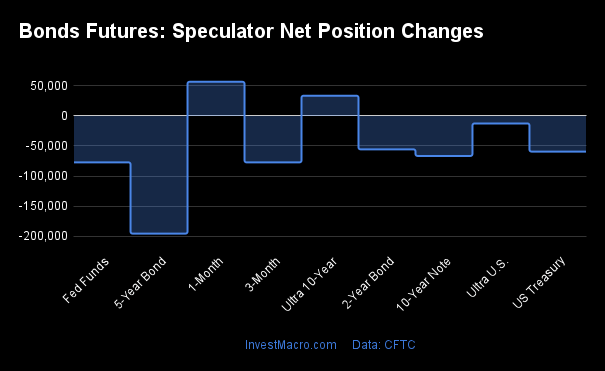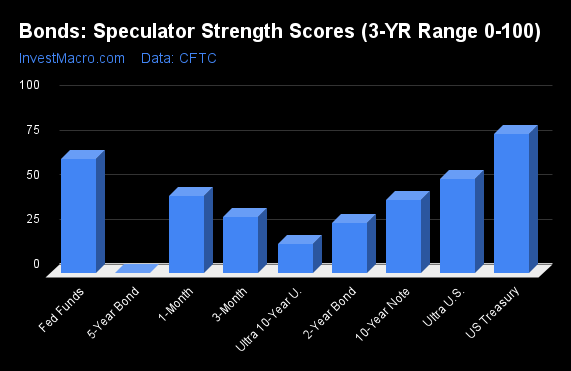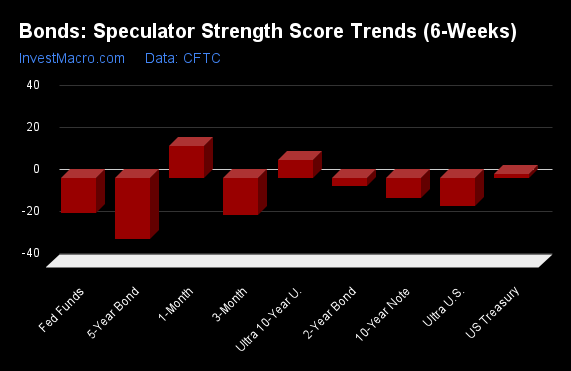By InvestMacro
Here are the latest charts and statistics for the Commitment of Traders (COT) reports data published by the Commodities Futures Trading Commission (CFTC).
The latest COT data is updated through Tuesday June 4th and shows a quick view of how large traders (for-profit speculators and commercial hedgers) were positioned in the futures markets.
Weekly Speculator Bets led lower by 5-Year Bonds
The COT bond market speculator bets were lower this week as only one out of the eight bond markets we cover had higher positioning while the other seven markets had lower speculator contracts.
Free Reports:
 Get our Weekly Commitment of Traders Reports - See where the biggest traders (Hedge Funds and Commercial Hedgers) are positioned in the futures markets on a weekly basis.
Get our Weekly Commitment of Traders Reports - See where the biggest traders (Hedge Funds and Commercial Hedgers) are positioned in the futures markets on a weekly basis.
 Download Our Metatrader 4 Indicators – Put Our Free MetaTrader 4 Custom Indicators on your charts when you join our Weekly Newsletter
Download Our Metatrader 4 Indicators – Put Our Free MetaTrader 4 Custom Indicators on your charts when you join our Weekly Newsletter
Leading the gains for the bond markets was the Ultra 10-Year Bonds with an increase by 33,731 contracts for the week.
The bond markets with declines in speculator bets for the week were the 5-Year Bonds (-195,920 contracts), the SOFR 3-Months (-77,320 contracts), Fed Funds (-77,263 contracts), the 10-Year Bonds (-66,580 contracts), the US Treasury Bonds (-59,326 contracts), the 2-Year Bonds (-55,603 contracts) and the Ultra Treasury Bonds (-12,463 contracts) also registering lower bets on the week.
Bonds Net Speculators Leaderboard
Legend: Weekly Speculators Change | Speculators Current Net Position | Speculators Strength Score compared to last 3-Years (0-100 range)
Strength Scores led by US Treasury Bonds & Fed Funds
COT Strength Scores (a normalized measure of Speculator positions over a 3-Year range, from 0 to 100 where above 80 is Extreme-Bullish and below 20 is Extreme-Bearish) showed that the US Treasury Bonds (78 percent) and the Fed Funds (64 percent) lead the bond markets this week. The Ultra Treasury Bonds (52 percent) comes in as the next highest in the weekly strength scores.
On the downside, the 5-Year Bonds (0 percent) and the Ultra 10-Year Bonds (16 percent) come in at the lowest strength level currently and are in Extreme-Bearish territory (below 20 percent). The next lowest strength scores were the 2-Year Bonds (28 percent) and the SOFR 3-Months (31 percent).
Strength Statistics:
Fed Funds (63.8 percent) vs Fed Funds previous week (81.3 percent)
2-Year Bond (28.2 percent) vs 2-Year Bond previous week (31.7 percent)
5-Year Bond (0.0 percent) vs 5-Year Bond previous week (11.7 percent)
10-Year Bond (40.6 percent) vs 10-Year Bond previous week (46.8 percent)
Ultra 10-Year Bond (16.4 percent) vs Ultra 10-Year Bond previous week (9.6 percent)
US Treasury Bond (78.1 percent) vs US Treasury Bond previous week (98.8 percent)
Ultra US Treasury Bond (52.4 percent) vs Ultra US Treasury Bond previous week (57.6 percent)
SOFR 3-Months (31.1 percent) vs SOFR 3-Months previous week (35.1 percent)
Ultra 10-Year Bonds & US Treasury Bonds top the 6-Week Strength Trends
COT Strength Score Trends (or move index, calculates the 6-week changes in strength scores) showed that the Ultra 10-Year Bonds (9 percent) and the US Treasury Bonds (2 percent) lead the past six weeks trends and are the only positive movers for bonds.
The 5-Year Bonds (-29 percent), the SOFR 3-Months (-17 percent) and the Fed Funds (-16 percent) lead the downside trend scores currently with the Ultra Treasury Bonds (-13 percent) following next with lower trend scores.
Strength Trend Statistics:
Fed Funds (-16.3 percent) vs Fed Funds previous week (1.3 percent)
2-Year Bond (-3.5 percent) vs 2-Year Bond previous week (-2.1 percent)
5-Year Bond (-28.9 percent) vs 5-Year Bond previous week (-11.0 percent)
10-Year Bond (-9.4 percent) vs 10-Year Bond previous week (-2.4 percent)
Ultra 10-Year Bond (8.6 percent) vs Ultra 10-Year Bond previous week (-3.5 percent)
US Treasury Bond (2.0 percent) vs US Treasury Bond previous week (20.8 percent)
Ultra US Treasury Bond (-13.3 percent) vs Ultra US Treasury Bond previous week (-9.7 percent)
SOFR 3-Months (-17.2 percent) vs SOFR 3-Months previous week (-18.6 percent)
Secured Overnight Financing Rate (3-Month) Futures:
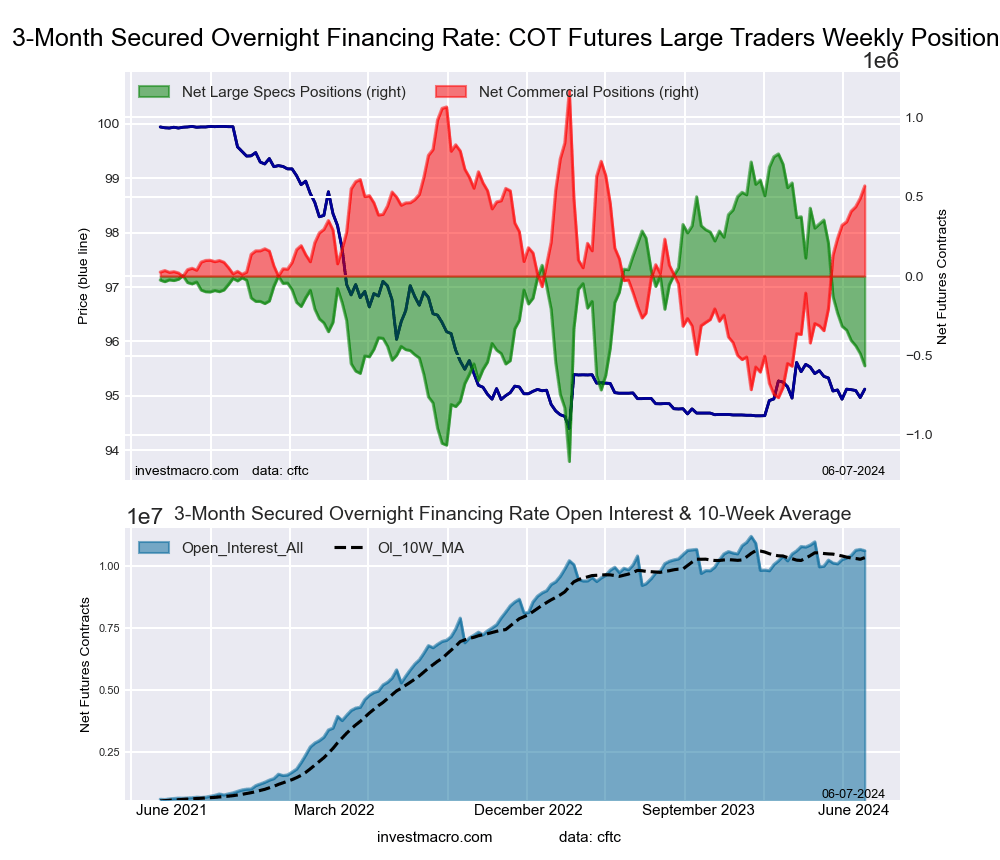 The Secured Overnight Financing Rate (3-Month) large speculator standing this week was a net position of -564,728 contracts in the data reported through Tuesday. This was a weekly fall of -77,320 contracts from the previous week which had a total of -487,408 net contracts.
The Secured Overnight Financing Rate (3-Month) large speculator standing this week was a net position of -564,728 contracts in the data reported through Tuesday. This was a weekly fall of -77,320 contracts from the previous week which had a total of -487,408 net contracts.
This week’s current strength score (the trader positioning range over the past three years, measured from 0 to 100) shows the speculators are currently Bearish with a score of 31.1 percent. The commercials are Bullish with a score of 69.0 percent and the small traders (not shown in chart) are Bullish-Extreme with a score of 86.2 percent.
Price Trend-Following Model: Weak Uptrend
Our weekly trend-following model classifies the current market price position as: Weak Uptrend. The current action for the model is considered to be: Hold – Maintain Long Position.
| SOFR 3-Months Statistics | SPECULATORS | COMMERCIALS | SMALL TRADERS |
| – Percent of Open Interest Longs: | 12.9 | 60.9 | 0.3 |
| – Percent of Open Interest Shorts: | 18.2 | 55.6 | 0.4 |
| – Net Position: | -564,728 | 567,744 | -3,016 |
| – Gross Longs: | 1,375,680 | 6,478,978 | 34,529 |
| – Gross Shorts: | 1,940,408 | 5,911,234 | 37,545 |
| – Long to Short Ratio: | 0.7 to 1 | 1.1 to 1 | 0.9 to 1 |
| NET POSITION TREND: | |||
| – Strength Index Score (3 Year Range Pct): | 31.1 | 69.0 | 86.2 |
| – Strength Index Reading (3 Year Range): | Bearish | Bullish | Bullish-Extreme |
| NET POSITION MOVEMENT INDEX: | |||
| – 6-Week Change in Strength Index: | -17.2 | 17.1 | 0.9 |
30-Day Federal Funds Futures:
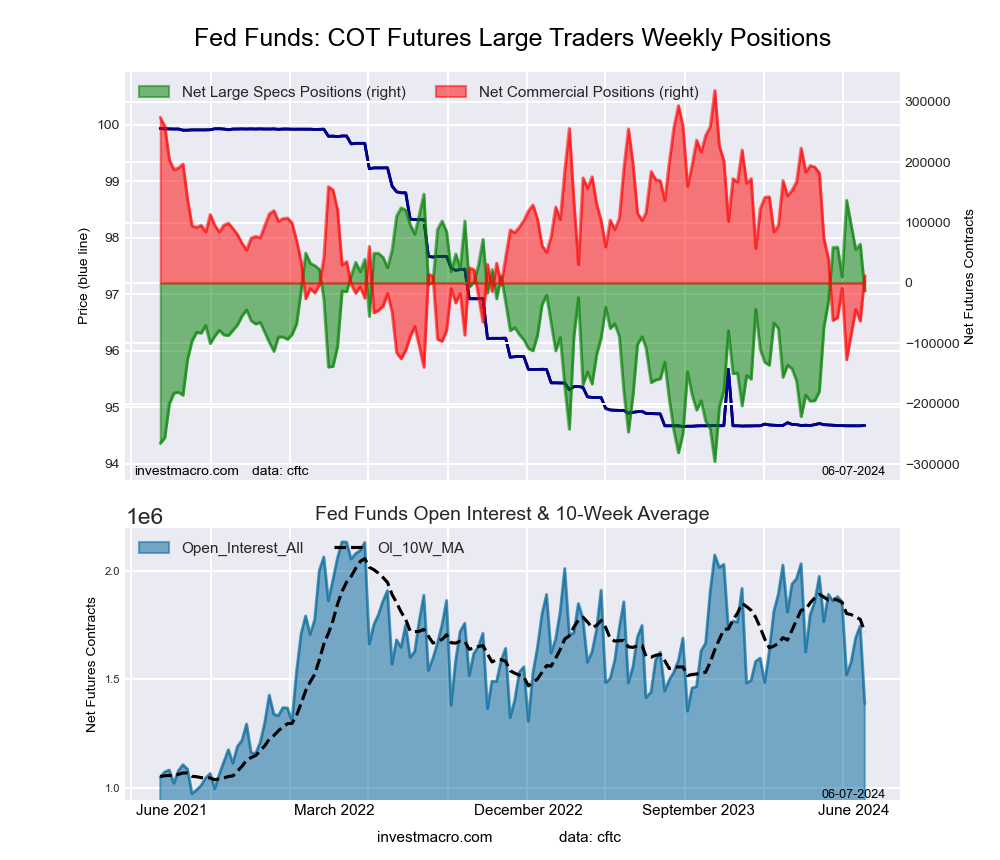 The 30-Day Federal Funds large speculator standing this week was a net position of -12,980 contracts in the data reported through Tuesday. This was a weekly reduction of -77,263 contracts from the previous week which had a total of 64,283 net contracts.
The 30-Day Federal Funds large speculator standing this week was a net position of -12,980 contracts in the data reported through Tuesday. This was a weekly reduction of -77,263 contracts from the previous week which had a total of 64,283 net contracts.
This week’s current strength score (the trader positioning range over the past three years, measured from 0 to 100) shows the speculators are currently Bullish with a score of 63.8 percent. The commercials are Bearish with a score of 33.2 percent and the small traders (not shown in chart) are Bullish-Extreme with a score of 92.1 percent.
Price Trend-Following Model: Downtrend
Our weekly trend-following model classifies the current market price position as: Downtrend. The current action for the model is considered to be: Hold – Maintain Short Position.
| 30-Day Federal Funds Statistics | SPECULATORS | COMMERCIALS | SMALL TRADERS |
| – Percent of Open Interest Longs: | 14.2 | 63.5 | 2.5 |
| – Percent of Open Interest Shorts: | 15.1 | 62.6 | 2.5 |
| – Net Position: | -12,980 | 12,406 | 574 |
| – Gross Longs: | 196,856 | 880,751 | 34,967 |
| – Gross Shorts: | 209,836 | 868,345 | 34,393 |
| – Long to Short Ratio: | 0.9 to 1 | 1.0 to 1 | 1.0 to 1 |
| NET POSITION TREND: | |||
| – Strength Index Score (3 Year Range Pct): | 63.8 | 33.2 | 92.1 |
| – Strength Index Reading (3 Year Range): | Bullish | Bearish | Bullish-Extreme |
| NET POSITION MOVEMENT INDEX: | |||
| – 6-Week Change in Strength Index: | -16.3 | 15.2 | 4.8 |
2-Year Treasury Note Futures:
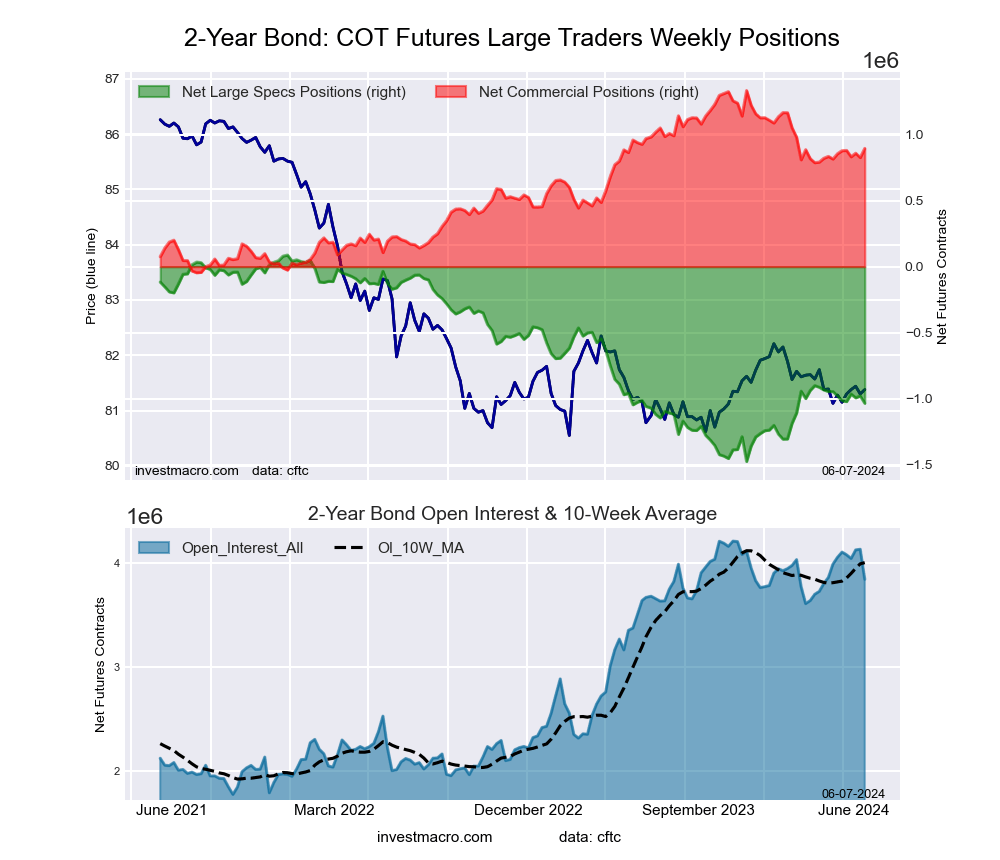 The 2-Year Treasury Note large speculator standing this week was a net position of -1,035,422 contracts in the data reported through Tuesday. This was a weekly decline of -55,603 contracts from the previous week which had a total of -979,819 net contracts.
The 2-Year Treasury Note large speculator standing this week was a net position of -1,035,422 contracts in the data reported through Tuesday. This was a weekly decline of -55,603 contracts from the previous week which had a total of -979,819 net contracts.
This week’s current strength score (the trader positioning range over the past three years, measured from 0 to 100) shows the speculators are currently Bearish with a score of 28.2 percent. The commercials are Bullish with a score of 68.2 percent and the small traders (not shown in chart) are Bullish-Extreme with a score of 94.9 percent.
Price Trend-Following Model: Downtrend
Our weekly trend-following model classifies the current market price position as: Downtrend. The current action for the model is considered to be: Hold – Maintain Short Position.
| 2-Year Treasury Note Statistics | SPECULATORS | COMMERCIALS | SMALL TRADERS |
| – Percent of Open Interest Longs: | 13.4 | 78.0 | 7.0 |
| – Percent of Open Interest Shorts: | 40.4 | 54.7 | 3.4 |
| – Net Position: | -1,035,422 | 895,943 | 139,479 |
| – Gross Longs: | 516,364 | 2,997,360 | 268,526 |
| – Gross Shorts: | 1,551,786 | 2,101,417 | 129,047 |
| – Long to Short Ratio: | 0.3 to 1 | 1.4 to 1 | 2.1 to 1 |
| NET POSITION TREND: | |||
| – Strength Index Score (3 Year Range Pct): | 28.2 | 68.2 | 94.9 |
| – Strength Index Reading (3 Year Range): | Bearish | Bullish | Bullish-Extreme |
| NET POSITION MOVEMENT INDEX: | |||
| – 6-Week Change in Strength Index: | -3.5 | 2.9 | 5.3 |
5-Year Treasury Note Futures:
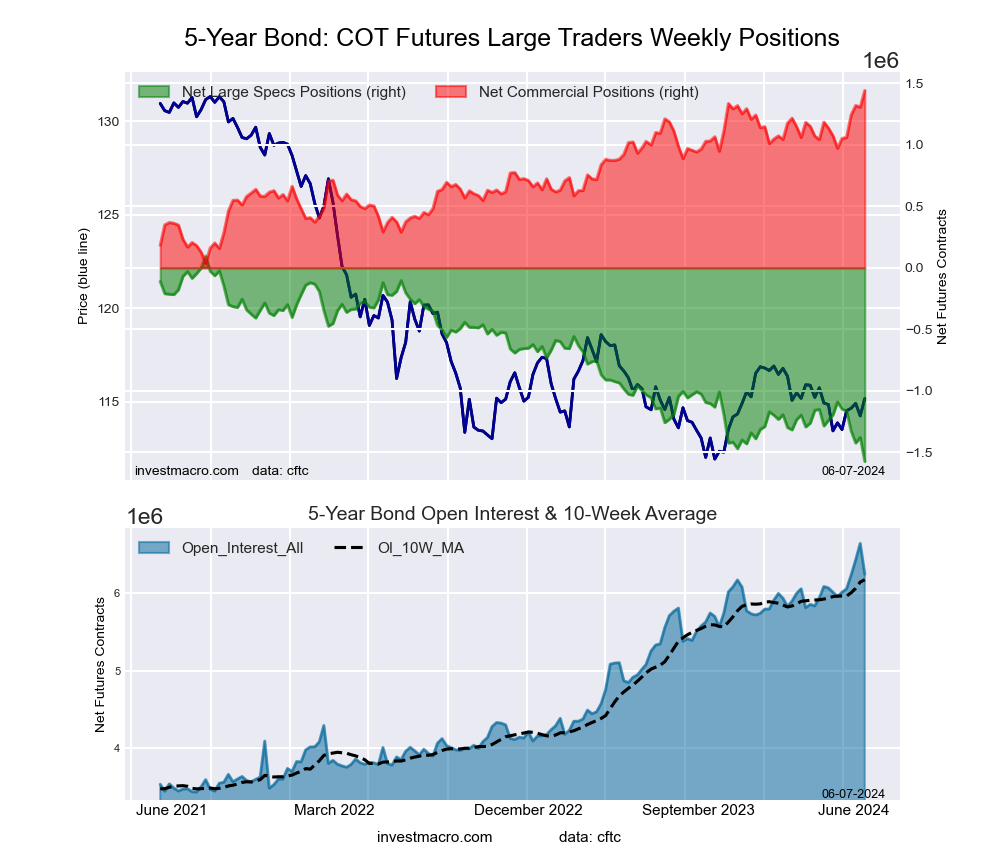 The 5-Year Treasury Note large speculator standing this week was a net position of -1,573,037 contracts in the data reported through Tuesday. This was a weekly decrease of -195,920 contracts from the previous week which had a total of -1,377,117 net contracts.
The 5-Year Treasury Note large speculator standing this week was a net position of -1,573,037 contracts in the data reported through Tuesday. This was a weekly decrease of -195,920 contracts from the previous week which had a total of -1,377,117 net contracts.
This week’s current strength score (the trader positioning range over the past three years, measured from 0 to 100) shows the speculators are currently Bearish-Extreme with a score of 0.0 percent. The commercials are Bullish-Extreme with a score of 100.0 percent and the small traders (not shown in chart) are Bullish-Extreme with a score of 91.1 percent.
Price Trend-Following Model: Downtrend
Our weekly trend-following model classifies the current market price position as: Downtrend. The current action for the model is considered to be: Hold – Maintain Short Position.
| 5-Year Treasury Note Statistics | SPECULATORS | COMMERCIALS | SMALL TRADERS |
| – Percent of Open Interest Longs: | 6.2 | 85.0 | 6.8 |
| – Percent of Open Interest Shorts: | 31.4 | 61.9 | 4.7 |
| – Net Position: | -1,573,037 | 1,439,949 | 133,088 |
| – Gross Longs: | 389,117 | 5,308,600 | 427,677 |
| – Gross Shorts: | 1,962,154 | 3,868,651 | 294,589 |
| – Long to Short Ratio: | 0.2 to 1 | 1.4 to 1 | 1.5 to 1 |
| NET POSITION TREND: | |||
| – Strength Index Score (3 Year Range Pct): | 0.0 | 100.0 | 91.1 |
| – Strength Index Reading (3 Year Range): | Bearish-Extreme | Bullish-Extreme | Bullish-Extreme |
| NET POSITION MOVEMENT INDEX: | |||
| – 6-Week Change in Strength Index: | -28.9 | 33.4 | 2.9 |
10-Year Treasury Note Futures:
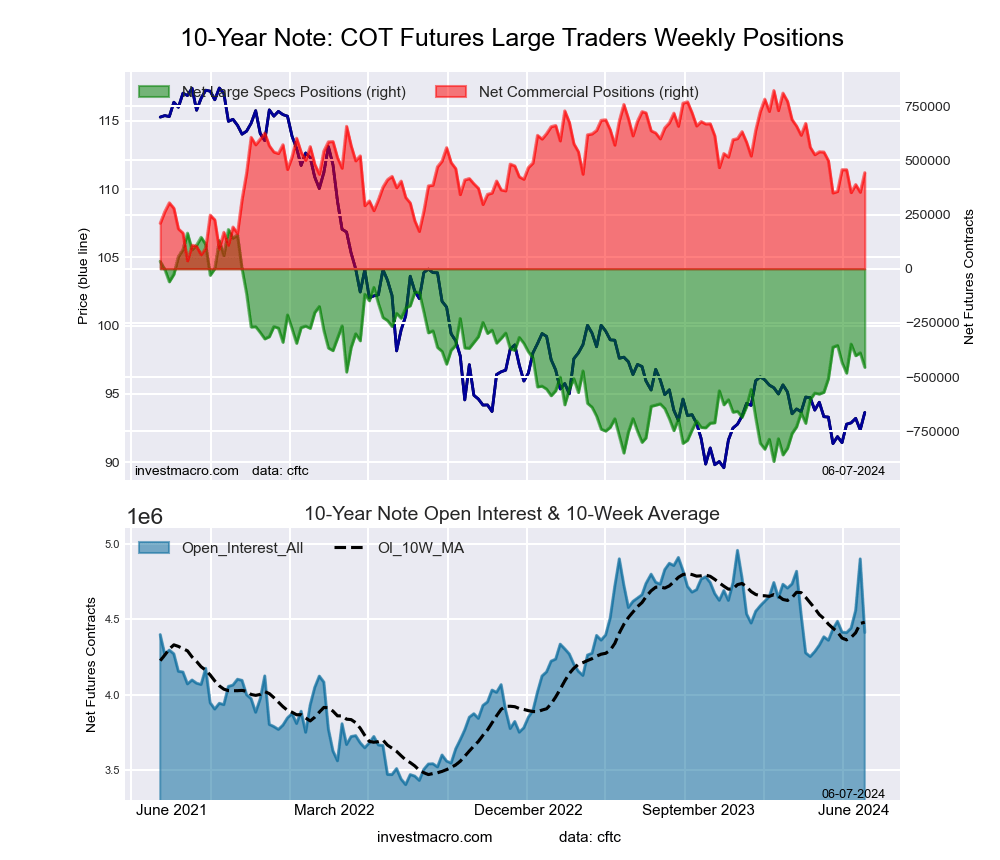 The 10-Year Treasury Note large speculator standing this week was a net position of -454,755 contracts in the data reported through Tuesday. This was a weekly fall of -66,580 contracts from the previous week which had a total of -388,175 net contracts.
The 10-Year Treasury Note large speculator standing this week was a net position of -454,755 contracts in the data reported through Tuesday. This was a weekly fall of -66,580 contracts from the previous week which had a total of -388,175 net contracts.
This week’s current strength score (the trader positioning range over the past three years, measured from 0 to 100) shows the speculators are currently Bearish with a score of 40.6 percent. The commercials are Bullish with a score of 51.8 percent and the small traders (not shown in chart) are Bullish with a score of 75.9 percent.
Price Trend-Following Model: Downtrend
Our weekly trend-following model classifies the current market price position as: Downtrend. The current action for the model is considered to be: Hold – Maintain Short Position.
| 10-Year Treasury Note Statistics | SPECULATORS | COMMERCIALS | SMALL TRADERS |
| – Percent of Open Interest Longs: | 10.1 | 77.4 | 9.2 |
| – Percent of Open Interest Shorts: | 20.4 | 67.3 | 9.0 |
| – Net Position: | -454,755 | 443,655 | 11,100 |
| – Gross Longs: | 447,213 | 3,415,649 | 406,545 |
| – Gross Shorts: | 901,968 | 2,971,994 | 395,445 |
| – Long to Short Ratio: | 0.5 to 1 | 1.1 to 1 | 1.0 to 1 |
| NET POSITION TREND: | |||
| – Strength Index Score (3 Year Range Pct): | 40.6 | 51.8 | 75.9 |
| – Strength Index Reading (3 Year Range): | Bearish | Bullish | Bullish |
| NET POSITION MOVEMENT INDEX: | |||
| – 6-Week Change in Strength Index: | -9.4 | 11.0 | 3.1 |
Ultra 10-Year Notes Futures:
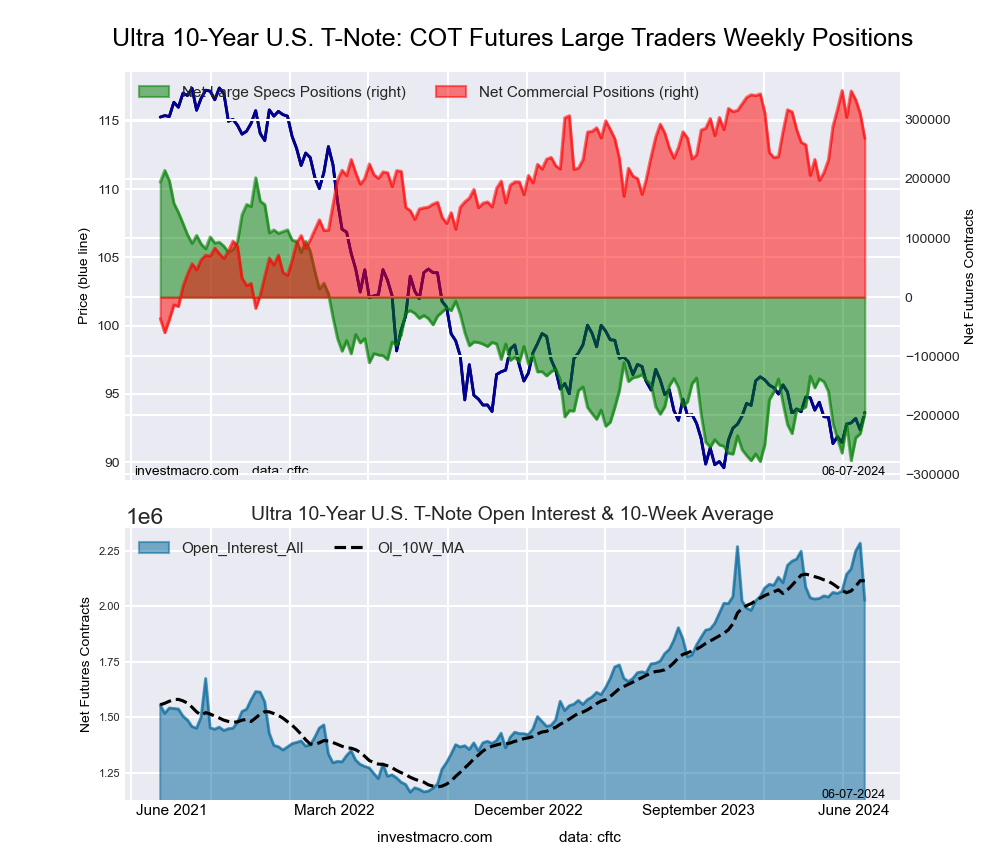 The Ultra 10-Year Notes large speculator standing this week was a net position of -197,034 contracts in the data reported through Tuesday. This was a weekly boost of 33,731 contracts from the previous week which had a total of -230,765 net contracts.
The Ultra 10-Year Notes large speculator standing this week was a net position of -197,034 contracts in the data reported through Tuesday. This was a weekly boost of 33,731 contracts from the previous week which had a total of -230,765 net contracts.
This week’s current strength score (the trader positioning range over the past three years, measured from 0 to 100) shows the speculators are currently Bearish-Extreme with a score of 16.4 percent. The commercials are Bullish-Extreme with a score of 80.2 percent and the small traders (not shown in chart) are Bullish with a score of 71.5 percent.
Price Trend-Following Model: Weak Uptrend
Our weekly trend-following model classifies the current market price position as: Weak Uptrend. The current action for the model is considered to be: Hold – Maintain Long Position.
| Ultra 10-Year Notes Statistics | SPECULATORS | COMMERCIALS | SMALL TRADERS |
| – Percent of Open Interest Longs: | 11.5 | 77.0 | 9.7 |
| – Percent of Open Interest Shorts: | 21.2 | 63.8 | 13.2 |
| – Net Position: | -197,034 | 268,521 | -71,487 |
| – Gross Longs: | 233,540 | 1,560,564 | 196,579 |
| – Gross Shorts: | 430,574 | 1,292,043 | 268,066 |
| – Long to Short Ratio: | 0.5 to 1 | 1.2 to 1 | 0.7 to 1 |
| NET POSITION TREND: | |||
| – Strength Index Score (3 Year Range Pct): | 16.4 | 80.2 | 71.5 |
| – Strength Index Reading (3 Year Range): | Bearish-Extreme | Bullish-Extreme | Bullish |
| NET POSITION MOVEMENT INDEX: | |||
| – 6-Week Change in Strength Index: | 8.6 | -12.1 | 4.2 |
US Treasury Bonds Futures:
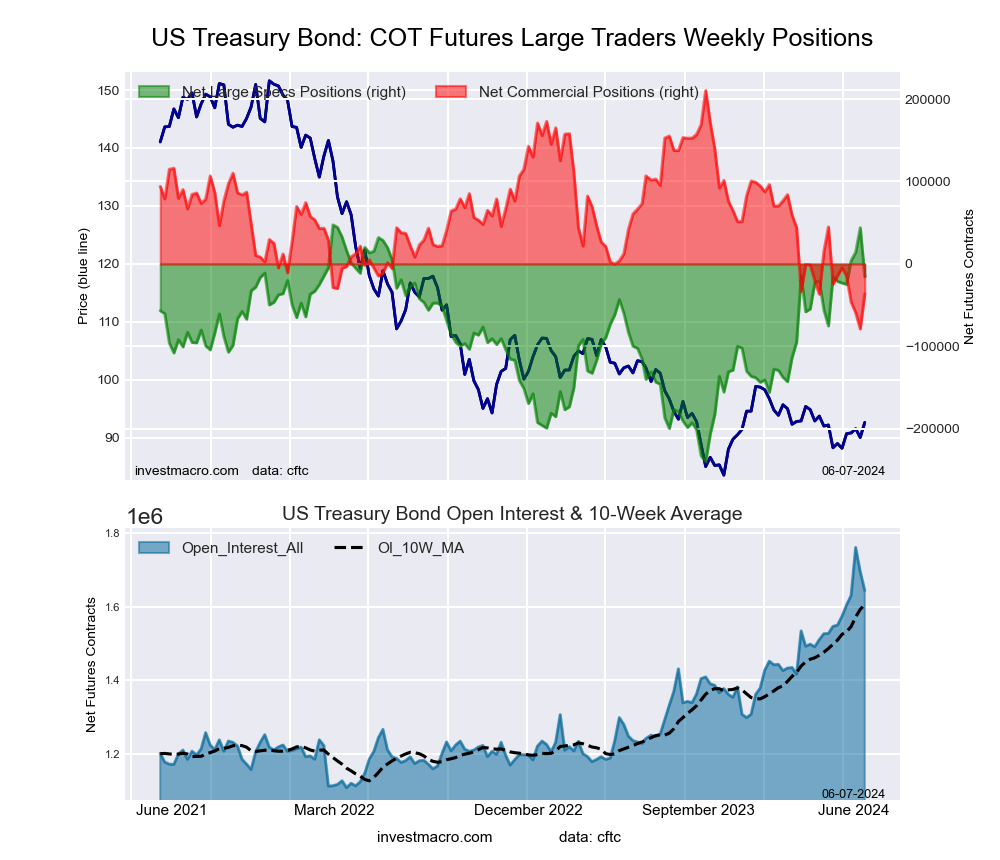 The US Treasury Bonds large speculator standing this week was a net position of -15,490 contracts in the data reported through Tuesday. This was a weekly decline of -59,326 contracts from the previous week which had a total of 43,836 net contracts.
The US Treasury Bonds large speculator standing this week was a net position of -15,490 contracts in the data reported through Tuesday. This was a weekly decline of -59,326 contracts from the previous week which had a total of 43,836 net contracts.
This week’s current strength score (the trader positioning range over the past three years, measured from 0 to 100) shows the speculators are currently Bullish with a score of 78.1 percent. The commercials are Bearish-Extreme with a score of 14.7 percent and the small traders (not shown in chart) are Bullish-Extreme with a score of 82.4 percent.
Price Trend-Following Model: Downtrend
Our weekly trend-following model classifies the current market price position as: Downtrend. The current action for the model is considered to be: Hold – Maintain Short Position.
| US Treasury Bonds Statistics | SPECULATORS | COMMERCIALS | SMALL TRADERS |
| – Percent of Open Interest Longs: | 17.5 | 68.5 | 12.7 |
| – Percent of Open Interest Shorts: | 18.5 | 70.7 | 9.6 |
| – Net Position: | -15,490 | -36,259 | 51,749 |
| – Gross Longs: | 288,078 | 1,126,050 | 209,030 |
| – Gross Shorts: | 303,568 | 1,162,309 | 157,281 |
| – Long to Short Ratio: | 0.9 to 1 | 1.0 to 1 | 1.3 to 1 |
| NET POSITION TREND: | |||
| – Strength Index Score (3 Year Range Pct): | 78.1 | 14.7 | 82.4 |
| – Strength Index Reading (3 Year Range): | Bullish | Bearish-Extreme | Bullish-Extreme |
| NET POSITION MOVEMENT INDEX: | |||
| – 6-Week Change in Strength Index: | 2.0 | -7.6 | 15.0 |
Ultra US Treasury Bonds Futures:
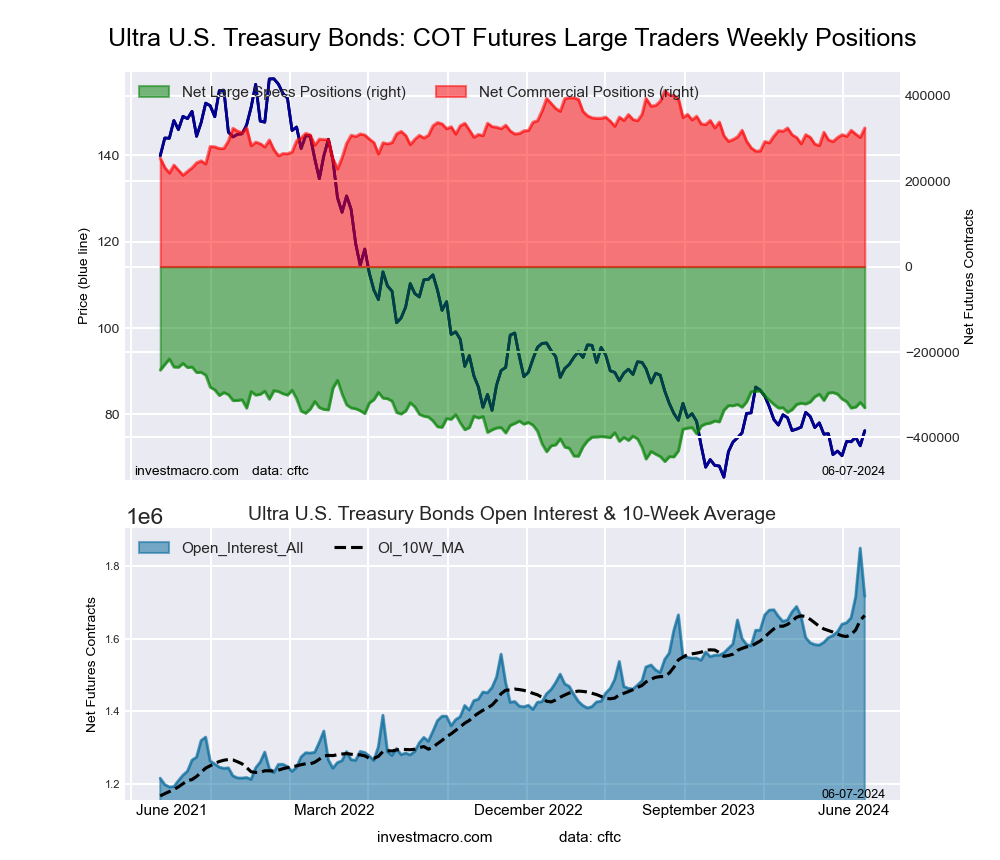 The Ultra US Treasury Bonds large speculator standing this week was a net position of -330,531 contracts in the data reported through Tuesday. This was a weekly decrease of -12,463 contracts from the previous week which had a total of -318,068 net contracts.
The Ultra US Treasury Bonds large speculator standing this week was a net position of -330,531 contracts in the data reported through Tuesday. This was a weekly decrease of -12,463 contracts from the previous week which had a total of -318,068 net contracts.
This week’s current strength score (the trader positioning range over the past three years, measured from 0 to 100) shows the speculators are currently Bullish with a score of 52.4 percent. The commercials are Bullish with a score of 55.8 percent and the small traders (not shown in chart) are Bearish with a score of 22.2 percent.
Price Trend-Following Model: Weak Downtrend
Our weekly trend-following model classifies the current market price position as: Weak Downtrend. The current action for the model is considered to be: Hold – Maintain Short Position.
| Ultra US Treasury Bonds Statistics | SPECULATORS | COMMERCIALS | SMALL TRADERS |
| – Percent of Open Interest Longs: | 8.6 | 78.7 | 10.5 |
| – Percent of Open Interest Shorts: | 27.9 | 59.8 | 10.1 |
| – Net Position: | -330,531 | 325,013 | 5,518 |
| – Gross Longs: | 147,782 | 1,351,715 | 179,644 |
| – Gross Shorts: | 478,313 | 1,026,702 | 174,126 |
| – Long to Short Ratio: | 0.3 to 1 | 1.3 to 1 | 1.0 to 1 |
| NET POSITION TREND: | |||
| – Strength Index Score (3 Year Range Pct): | 52.4 | 55.8 | 22.2 |
| – Strength Index Reading (3 Year Range): | Bullish | Bullish | Bearish |
| NET POSITION MOVEMENT INDEX: | |||
| – 6-Week Change in Strength Index: | -13.3 | 11.4 | 12.1 |
Article By InvestMacro – Receive our weekly COT Newsletter
*COT Report: The COT data, released weekly to the public each Friday, is updated through the most recent Tuesday (data is 3 days old) and shows a quick view of how large speculators or non-commercials (for-profit traders) were positioned in the futures markets.
The CFTC categorizes trader positions according to commercial hedgers (traders who use futures contracts for hedging as part of the business), non-commercials (large traders who speculate to realize trading profits) and nonreportable traders (usually small traders/speculators) as well as their open interest (contracts open in the market at time of reporting). See CFTC criteria here.

- GBP/USD Hits 21-Week High: The Pound Outperforms Its Peers Apr 3, 2025
- Most of the tariffs imposed by the Trump administration take effect today Apr 2, 2025
- EUR/USD Declines as Markets Await Signals of a Renewed Trade War Apr 2, 2025
- “Liberation Day”: How markets might react to Trump’s April 2nd tariff announcement? Apr 2, 2025
- The RBA expectedly kept interest rates unchanged. Oil rose to a one-month high Apr 1, 2025
- World stock indices sell off under the weight of new tariffs Mar 31, 2025
- COT Metals Charts: Speculator Bets led by Copper & Palladium Mar 30, 2025
- COT Bonds Charts: Speculator Bets led by 10-Year Bonds, Fed Funds & 2-Year Bonds Mar 30, 2025
- COT Soft Commodities Charts: Speculator Bets led by Sugar & Live Cattle Mar 30, 2025
- COT Stock Market Charts: Weekly Speculator Bets led this week by Nikkei 225 Mar 30, 2025

